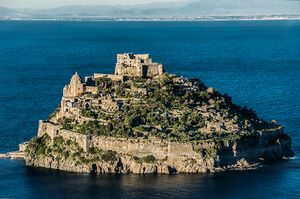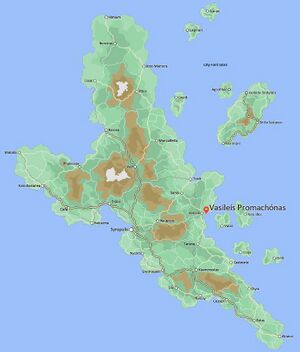Vasileís Promachónas
Template:Use dmy dates Template:Use British English
| The King's Bastion | |
|---|---|
Vasileís Promachónas | |
| Rock of Constantinte, Hericos, Grand Athantos, Sofrezia | |
Vasileís Promachónas from the South | |
| Type | castle |
| Height | 113 metres |
| Site information | |
| Owner | Sofrezian Heritage Organisation |
| Condition | Intact |
| Site history | |
| Built | 451BC |
| Built by | Dardanos I of Dia |
| Materials | Limestone |
| Battles/wars | Seige of Vasileís Promachónas, Serdiz Revolutionary War (1196). Skirmish on the Spit, War of the Bears and the Bones (1504). Battle on the Rock, The November Catastrophe (1645). Defence of the White Prince, War of the Two Pirates (1764). |
| Garrison information | |
| Past commanders | Basileus Bacchios II of Athantos (1196). The Seastone King, Leo Amanos (1764) |
| Garrison | 4,000 at peak (1888) |
The Kings Bastion (Frezii: Vasileís Promachónas) is a medieval castle close to the city of Hericos on the eastern side of Grand Athantos, Sofrezia. The castle stands atop a rocky islet that was named after one of the earliest leaders of Serdizica, Bacchios Constantine I, and connects to the mainland via a narrow causeway that was constructed in 1451.
The earliest beginnings of a fortress was laid down in 451 by Dardannos I of Dia, the youngest son of the Archon of Hericos, Epimetheus. Early plans consisted of two simple towers that would sit on the highest and lowest points of the islet, one guarding the coast and the other guarding the only navigable passage onto the rock itself. The main purpose of these defenses were to guard the entrance to the Tirinis River that lead to the harbour at Hericos. This was to prevent enemies from being able to sack the city as they had done so in 544BC in the short lived Diannsian War between Hericos and the Island of Dia.
(Work in progress)

